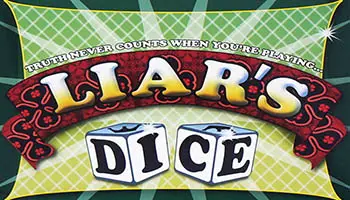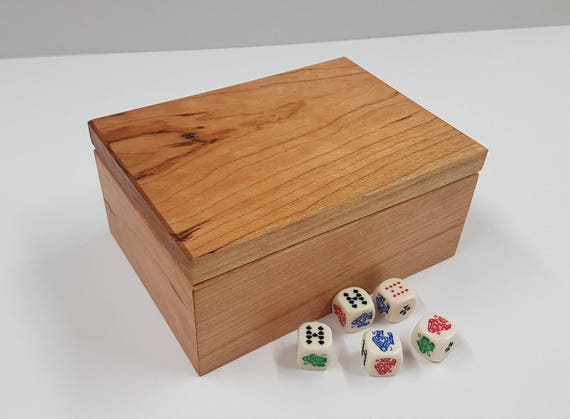Liar's Dice Poker Hands

This version of Liar's Dice uses Poker Dice hands, which are (from highest to lowest): Five of a kind Four of a kind Full house (Three of a kind and a pair). Liar Dice, its Variants and Rules Liar dice, which is in practice the same as poker dice, has been played for 100 years or more and exists in several slightly different forms. Most poker dice have on their sides the symbols of the highest playing cards, ace, king, queen, jack, ten and nine. There are variants between countries on how Liar's Dice allows 'hands' of dice. (There is also a version where you are. Liar's dice is a class of dice games for two or more players requiring the ability to deceive and to detect an opponent's deception. In 'single hand' liar's dice games, each player has a set of dice, all players roll once, and the bids relate to the dice each player can see (their hand) plus all the concealed dice (the other players' hands). The same $200 daily multiplayer gambling allowance is shared between Liar's Dice and Poker. If a player enters a Liar's Dice lobby with insufficient funds to buy into the game, $200 will be added to the player's account (limit of once per day). Players have a time limit within which to make their bid.
Home > Steve > Go > Liar dice Bid list
The rules of the game commonly played at Go events.
The BGA Rules
Liar dice is a game for any number of players using a set of five poker dice. Each die is marked with Ace (A), King (K), Queen (Q), Jack (J), ten (T) and nine (9); the faces, as listed here, are in order of value with Ace being the best.

(Inaccurate) Summary
The dice are rolled and offered to the next player along with a claimed poker style bid better than the previous bid. When a bid is challenged the offerer or recipient lose a life depending upon whether the bid was genuine or a lie. Each player has three lives.
Play

Any number of players sit round a convenient table so that a set of poker dice can be passed clockwise from player to player without disturbing the rolls. The game is best with 5-8 players.
The starting player is determined by highest die roll. Matching highest players re-roll to tie-break.
In turn, each player roles all / some / none of the dice at his discretion, usually hiding them from the other players' view. The starting player must roll all 5 dice. A player must state accurately how many dice he is rolling. This last sentence was queried when these rules were discussed. The conclusion was that the rule stands.
Apparently there is a Dutch / EGF rule variant which only permits rolling none if you have not looked at what was passed.
He then offers the (usually hidden) dice to the player on his left stating that they are some poker bid (excluding runs). This bid must be better than the offer made when he accepted the dice. (The starting player may name any bid).
The next player may either accept the dice and have his turn, or he may challenge. If challenging, the dice are exposed. If the hand equals or betters the stated bid, the recipient loses a life and the dice pass to the player on the recipient's left who starts again. If the hand is worse than the bid then the offerer loses a life and the recipient becomes the starting player.
The above procedure is often done in a confusing manner in order to make other players play harder.
Each bid need not be fully specified, in which case it is deemed to be the weakest possible bid meeting constraints stated. Better is a valid bid, as is Way better meaning Better than better, etc.
Liar's Dice Poker Hands Game
Should a player make an undercall, it is treated as Better. The undercall can be pointed out by any player at any point in the future of this hand, up to and including the exposure of a challenged set of dice.
When the bid reaches five aces (AAAAA), the player who needs to improve the bid must roll all and then may roll all / some / none of the dice twice more to achieve another five aces. If he achieves this then no-one loses a life and the next player starts a new hand, otherwise he loses a life.
Each player has three lives and is out of the game when he has lost them all. The winner is the final player with a life. As a concession to the first player to lose all three lives, he may get an extra life by standing and 'barking like a dog' (a decent howl, not just saying 'woof'). Should a player decline the dog's life, it remains available for a subsequent player to claim on losing his last life.
If a player is absent when his turn comes, perhaps buying a round of drinks, he is deemed to have accepted the bid and to be passing the dice, unrolled, on as 'Better'. This is the Königswinter rule.
Bids
There are no runs in liar dice. Getting progressively stronger, the types of bids are:
- Singleton
- A pair
- Two pairs
- Three of a kind
- Full house (3 of a kind plus 2 of a kind, the 3 being more valuable)
- Four of a kind
- Five of a kind.
Liardice.txt is a list, in sequence, of all the 252 possible bids, along with their frequency and category.
Here follows an example, stating what was said and what it means:
- A pair
- 99QJT
- A better pair
- 99KJT
- A pair of Jacks
- JJQT9
- A pair of Jacks with no ten
- JJKQ9
A bid is often just 'better'. You have to pay attention since after 3 or 4 'betters' in a row, it is easy to lose track of what level the bid has reached.
There is no obligation for a player to repeat his bid to clarify a situation for any player once the dice have been accepted by the recipient.
You must be truthful about the number of dice that you roll. You do not have to be truthful about which dice you are rolling. For example, if you accept a bid of 'four of a kind' (implying 9999T) and it happens to be JJJJQ, then you can roll 1 die - stating 'rolling one die - a singleton Queen' and actually roll one of the Jacks to trash the hand for the next player.
Techniques
You do not have to look at the dice on your turn, though it is wise to do so.

Liar's Dice Poker Hands Against

Certain confusions are in standard usage, for example 'three pairs of Jacks' actually means 'three jacks' as the 3 pairs are J1+J2, J2+J3 and J3+J1! Similarly six pairs means four of a kind.
It is necessary to remember what the most recent bid is - even if this is determined by analysing 'betters'. It is advisable to remember exactly what dice you passed on to your left and how many dice each player has thrown since you saw them.
Cooperation with the players to your left and right is a good strategy, ganging up on the players on the far side of the table.
An example hand
In a four player ( [a], [b], [c] and [d] ) game.
[a] rolls TTAQ9 and offers 'a pair' meaning 99QJT.
[b] rolls 3 dice (AQ9) to get KKTTJ and offers 'two pairs' meaning TT99J.
[c] rolls one die (J) to get KKTT9 and offers 'better' meaning TT99Q.
[d] rolls 3 dice (TT9) and gets KKKAJ and offers 'two pairs, jacks on top' meaning JJ99T.
[a] rolls no dice and offers 'three queens'. [b] challenges and loses a life as the dice are 'three kings' which betters the bid of three queens.
[b] thus misses a turn and [c] starts the next hand.
The above may not be good quality play, but it is a valid hand.
Specialist Terminology
- Prial
- Three of a kind. From pair-royal.
- Königswinter
- See paragraph above.
Home > Steve > Go > Liar dice Bid list
British Go Association
Last updated 2017-08-26
This page is part of http://www.stocton.org/
Email: webmaster@stocton.org